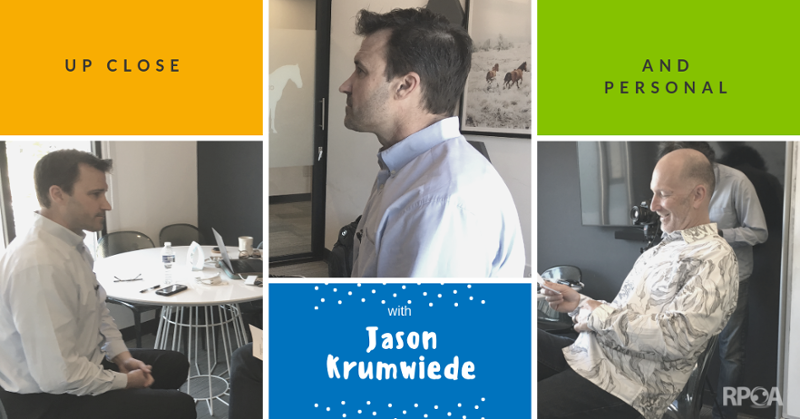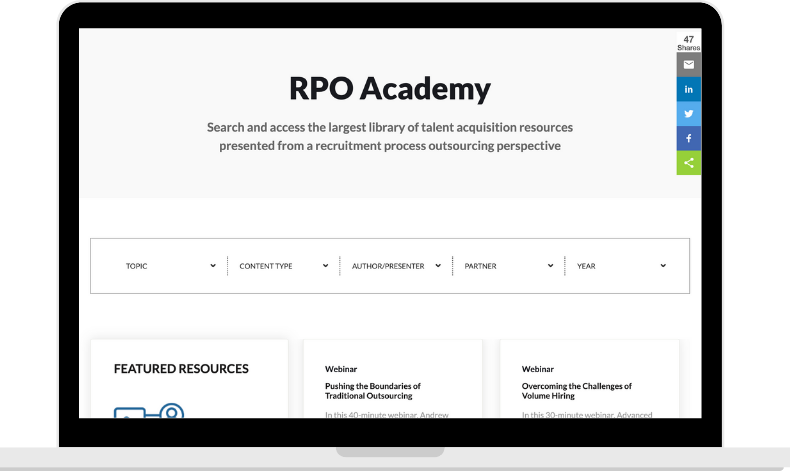-min.jpg?width=800&height=533&name=iStock-2160830120%20(1)-min.jpg)
Polaris research shows the RPO recruitment market will grow from 9 billion dollars to 32 billion dollars by 2032, opening new opportunities for recruitment agencies.[1] In our latest RPO Leadership Forum hosted by RPOA CEO Lamees Abourahma, Paul Sharpe, and Miles Lloyd, co-founders of Northstar People, shared their expertise on transitioning from contingent recruitment to sustainable talent solutions through RPO.
The article outlines Sharpe and Lloyd's presentation and provides a blueprint for recruiting providers interested in or curious about transitioning from traditional contingent recruitment to an RPO model.
Watch the webinar to start your journey of building an RPO Company in the UK.
What is RPO?
RPO fundamentally differs from traditional staffing models in permanent recruitment delivery. Sharpe explained, "RPO, for me, is about permanent recruitment, distinct from contingent recruitment covering contractors and temporary employees."
This distinction matters because traditional contingent recruitment creates inherent instability. Lloyd described this challenge: "You can do the perfect job, be perfect, but still fail, because we're dealing with people and unknown quantities within people."
The economic effect of this transition proves significant. Lloyd showed the hidden costs of traditional recruitment: "When is the 20% fee not a 20% fee? When we're doing it on a contingent basis. A bloody good contingent recruiter in the UK will fill one in two vacancies. So that 20% fee, for all the work and effort we've put in on two jobs, that 20% is covering two jobs. It's 10% if you do it that way."
The RPO model addresses these challenges by changing fundamental business relationships. "What's RPO all about?" Lloyd asked. "If you do it well and do it right, it will mean you can get clients that maybe you couldn't get without that solution."
Sharpe emphasized the core purpose: "The purpose of RPO is representing the customer's best interests. You're driving agency usage down while driving internal mobility, referrals, and direct hires up. This mindset shift proves essential for success."
1. Why 76% of Agency Owners and Leaders Are Looking at RPO Solutions as the Future
"After every tight labor market, RPO has bounced back quicker than most sectors," Sharpe explained. "This resilience stems from fundamental market dynamics. As talent acquisition teams face increased pressure with reduced resources, RPO offers stability and growth."
For agency owners, RPO addresses persistent business challenges. Lloyd described the current reality: "Many agency owners are just sick to death of it and doing this roller coaster and being on this hamster wheel. The traditional model creates inherent instability: "Soon as we win a customer, we're going to lose a customer," he said.
RPO offers a different approach. "We need to make sure that we keep hold of them as long as possible, and we maximize the opportunity in a positive, mutually beneficial way with that client over an extended period," Lloyd emphasized. This leads to "something that's contracted, something where we can add a lot more value, where we can actually have an impact for the customer beyond putting a bum on a seat."
Lloyd reinforces why agency owners are moving toward RPO.
2. Essential Pre-Investment Considerations
"Wanting to do and deciding to do an RPO isn't an easy, simple decision," Lloyd emphasized. "This isn't dressing up recruitment in some emperor's new clothes."
Success requires total organizational commitment. "You're going to have to give it absolute focus and attention, done well and done right," Lloyd explained. "This has to be driven from the top through an organization. The time element and ownership piece are critical. This isn't a part-time job."
3. Starting Point: Customer Segmentation
Customer segmentation forms the foundation of a successful RPO transition. As Sharpe explained, "Whatever you do in recruitment, whether you build an RPO solution or you just run a recruitment business, we always start looking at the existing customer base."
This focus on existing relationships stems from a sobering industry reality. "The average retention rate in the industry is 50%," Sharpe noted. "For every two customers, you're going to lose one every year." Even more concerning, "20 to 27 percent of recruitment agency owners do not measure client retention. That's shocking. That's not far off a third."
Sharpe and Lloyd developed a systematic approach to evaluate client relationships. The process examines three years of customer data across five key criteria: exclusivity, fee levels, line manager access, repeat roles, and relationship depth. They visualize this data using a practical method: "You put your customer name on a Post It note, and depending upon whether you get five out of those five criteria, you put it on a different post it note," Sharpe said.
This analysis reveals crucial insights about RPO readiness. "If you haven't got a lot of customer relationships in that top upper quadrant," Sharpe cautioned, "the first thing you probably need to do is invest in your customer relationships. Don't do RPO because the chances of actually selling to customers is quite hard, especially when it's a brand new service line."
4. Building Your Minimal Viable Product
After customer segmentation, you must develop your service proposition or minimal viable product (MVP). As Sharpe explained, this process begins with examining your current capabilities: "Most recruiters have probably done elements of RPO. If I talk about market mapping, a lot of recruiters will go, 'Yep, I've done that.' If I say, have you done some benchmark salary benchmarking, people will say, 'Yeah, I've done bits of that.'"
A complete RPO service proposition encompasses five essential channels: strategy, attraction, sourcing, selection, and onboarding. "Start to break down each one of those channels," Sharpe advised. "What is it that you've done? What does the service look like, and what do you think your customer might value?"
However, Sharpe emphasized a crucial caveat: "A recruitment agency is part of the sourcing channel, and an agency does that much of a process. So we have to shift our mindsets from thinking what we want to provide as a recruiter versus what the customer might value."
This mindset shift proves essential because many recruiters make a fundamental mistake. "The danger here," Sharpe cautioned, "is they assume that is what the customer wants. I am always pleasantly surprised that when I go and talk to a customer and say, 'This is the service proposition of an RPO,' they will frequently say to me, 'I don't want that,' or 'there's something missing here.'"
This reality underscores why careful service development matters. "When you're starting off in selling RPO solutions," Sharpe noted, "your brand isn't known for selling RPO services, so this relationship piece and trying to think about what the customer would really value is really important. You frequently get one chance to sell these, and if you get it wrong and miss the dartboard, you probably won't get a second chance."
5. Testing Your Service Offering
The Kano analysis helps validate service offerings with potential clients. Lloyd explained its value: "It allows us to take a virtual concept of a product value proposition, go to our customers, and through questioning, find out whether what we think is a good idea actually meets their needs."
The process typically validates much of the initial service concept while revealing crucial gaps. "Usually, most organizations get it about 85 percent right," Lloyd noted, "but there's little stuff that we've missed, or there's things we didn't think important that actually are really critical."
6. Taking Your Service to Market
Successfully bringing RPO solutions to market requires sophisticated stakeholder engagement. "This isn't just about having some slick marketing campaign," Lloyd explains. "You're going to have to go and have meaningful conversations with different decision-makers."
The sales cycle requires patience. "Be prepared that it might take a little bit of time," Lloyd advised. "It's not a quick fix for revenue or anything like that. But if you're in it, actually, this will be game-changing over a three-year cycle with an organization."
Sharpe suggested leading with market insights: "I'd never say, 'Can I come and talk to you about RPO.' I'd say, 'Can I come and talk to the leadership team about market trends, thought leadership, data points, things you should be aware of, some competitor analysis.'"
7. Developing Your Pricing Strategy
Many agencies make a fundamental pricing mistake. As Sharpe warned: "About 85 percent of business owners start with their standard contingency fee - maybe 20 percent - then offer a small discount for the RPO contract. That is absolutely the wrong way to do it."
Instead, successful pricing starts with comprehensive data analysis about hiring patterns, role types, and current recruitment channels. This detailed understanding enables pricing that reflects true delivery costs and value, he said,
See RPO Pricing Models for more in-depth insight into RPO pricing.
8. Technology Requirements
Technology forms an essential foundation for RPO delivery. "If you haven't got the right tech, forget it," Lloyd emphasized. He explained that standard recruitment CRMs won't suffice: "It needs to be an applicant tracking system." This distinction matters because "organizations pay significant money for RPO services. They expect to own their talent pools and recruitment data."
The right technology infrastructure supports long-term client relationships. Lloyd emphasized this point through real-world experience: "At the end of any journey, the client might change their mind. They may decide they want to insource rather than outsource." Therefore, technology choices must consider potential transitions while maintaining data integrity and accessibility.
"The great news is nowadays," Lloyd added, "if this was a number of years ago, very expensive, difficult to implement, just a bloody nightmare. Now there's some great tech out there that's software as a service. So you're not having to invest in huge amounts of tech. It's not going to be cumbersome."
RPO Certificate: Learn the foundations of an RPO business from an industry legend.
Conclusion
The journey from traditional recruitment to an RPO model transforms how agencies create and deliver value. Those who follow these nine essential steps while maintaining focus on proper execution will find themselves well-positioned to succeed in the evolving recruitment landscape.
We encourage you to visit the RPO Academy to learn more about transitioning from traditional contingent recruitment to an RPO model.





-min.jpg)








